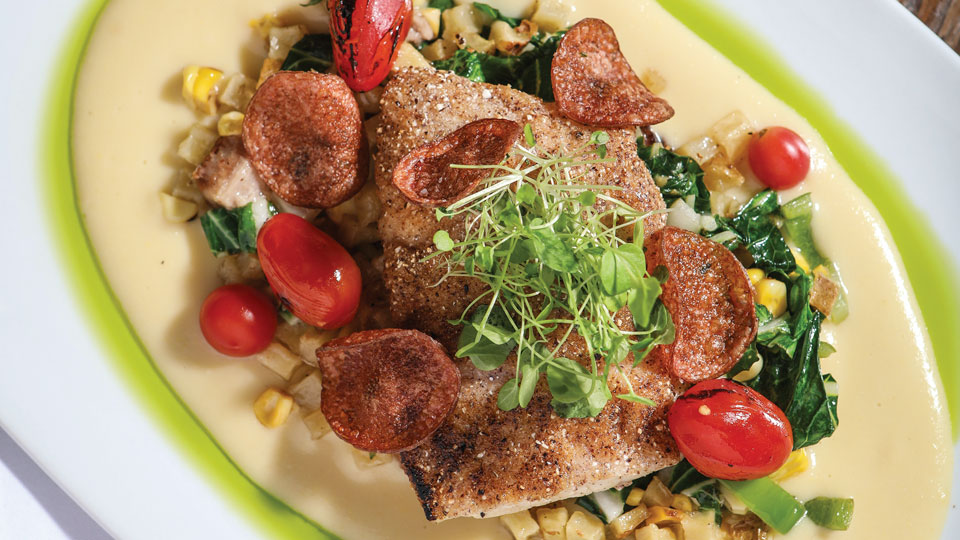Photos by Jessica Ebelhar
“We do, at minimum, about 20,000 pounds a week,” says Lula Luu, owner of Fin Gourmet in Paducah. “Last year we put away a little over one million pounds.” She’s talking Asian carp, which you might know as Kentucky carp, Kentucky Blue or silver carp. It’s an invasive fish species that she says can be found in almost every inland waterway in the U.S. Fin Gourmet produces deboned filets of Asian carp, typically caught in Kentucky Lake or Lake Barkley in the western part of the state, and sends them around the country: 300 pounds to Elon Musk’s SpaceX company, to a chef at the White House who smoked it for President Obama, to restaurants in Lexington, Florida, Nashville. In Louisville, Fin Gourmet has supplied Asian carp to Ward 426, the Oakroom in the Seelbach, Wiltshire on Market, Mayan Cafe and Harvest.

Photo: Tikin Xic: Asian carp, black rice, fried plaintains and achiote sauce from Mayan Cafe.
“When it comes to fish sometimes, especially locally in Kentucky, it’s kind of hard to convince me personally,” says Bruce Ucan, chef-owner of Mayan Cafe on East Market Street. His restaurant offers two oversized, pan-fried Asian carp filets atop a mound of black rice and fried plantains, topped with a citrus achiote sauce — Ucan’s take on the Yucatecan dish Tikin Xic. His food truck at Gravely Brewing Co. serves grilled Asian carp fish tacos, topped with a sweet and spicy pineapple-poblano salsa and a jalapeño aioli for added heat. “For the restaurant, it was a little challenging in the beginning,” says Ucan, who orders about 100 pounds of Asian carp each month. “People, when they think about (this) fish, it’s funny. But once they eat it, they’re like, ‘Man, this is awesome!’”
The fish has a mild flavor and no overt fishy smell. It can be fried, grilled, smoked or served as ceviche or sashimi. As a “filter-feeder” at the top of the water, it doesn’t eat other fish, meaning low traces of contamination or mercury. And you don’t have to feel guilty eating it because it can’t be over-fished. “One female — just one female — in a year can lay up to a million eggs,” Luu says. “About a quarter of that is going to become adults. You can imagine the multiplication of this population.” And these aren’t small fish. An adult Asian carp can get up to 100 pounds. Originally bred to be farmed, the fish crept into wild waterways due to flooding in the Mississippi Delta. A fish that grows and reproduces as quickly as the Asian carp, with no natural predators, will push out other native species. They’re a nuisance to humans as well. If a boat grazes the water where the fish are feeding, a sort of static electricity causes them to jump. “A fish is flying through the air and you’re having to be the wall that it collides into,” Luu says. “It’s going to be painful.”

Photo: Carp Niçoise from Harvest.
Luu says Fin Gourmet started by accident. In 2010, Luu was working in New Orleans as a researcher at LSU’s medical school and co-founded a nonprofit to help folks in the community access healthcare. Then came the BP oil spill in the Gulf of Mexico. “Long story short, a lot of the people we were working with could no longer have a living because they couldn’t go out into the Gulf to do shrimping or fishing,” she says. “We thought, naively: They have boats and nets. How difficult can it be to fish inland?” In just a year, Luu put 100,000 miles on her Camry driving across the Delta region, researching Asian carp. They lab-tested the fish to determine whether it was healthy or safe to eat. “The (only) problem that we saw was that it’s too bony,” she says. “The mainstream American palate does not know how to eat fish with bones in it.” Eventually she and her business partner, John Crilly, connected with commercial fisherman Ronny Hopkins in Ledbetter near Paducah. “It’s a fish that’s putting Kentucky on the map,” Luu says.
Fin Gourmet keeps extensively maintained fish logs, a tracking system uncommon for many wild-caught fish. “Ninety percent of seafood that we eat, we have no idea where it’s from or who made it,” Luu says. “If a customer at Mayan Cafe asked, ‘When was this fish caught?’ I can bring out the fish log and tell them exactly who caught it, where it was caught, what time it was brought in, down to the person who packaged it.”

Photo: Carp on corn chowder from Harvest.
Harvest chef Patrick Roney had challenges pitching the fish. “A lot of customers kind of shun it when they first hear it,” he says. “Once they’ve tried it, we’ve got people coming back specifically for the carp.” Harvest has served it several ways: ceviche-style, fried, grilled to top a Niçoise salad, mixed into the creamy inside of a pickled deviled egg. Harvest’s big menu item features a thick filet crusted in blue corn meal, with smooth corn chowder as a sauce. Underneath, it’s paired with thick, roasted potatoes and pork belly. “I wouldn’t put it on the menu if it didn’t taste really good,” Roney says.
This originally appeared in the November 2017 issue of Louisville Magazine. To subscribe to Louisville Magazine, click here. To find us on newsstands, click here.



